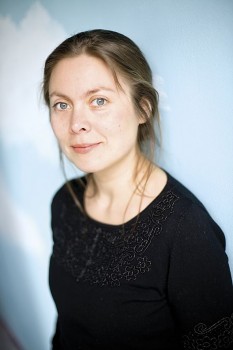In the same boat
29 May 2012 | Authors, Interviews, Reviews

Pauliina Haasjoki. Photo: Tommi Tuomi
For the poet Pauliina Haasjoki, a writing process can begin in many ways, but particular periods – residencies, for example – are dedicated to writing. She attempts to create a cross-swell of influences in which she may read, watch movies, listen to music, have conversations and wander, collecting memories.
In the end, beginning to write becomes easy. Haasjoki may put music on to play, for example, for a certain time and use it to write ‘the poetry that belongs to that time, which sort of jostles there, waiting, because I have put it there.’
Haasjoki’s writing career began in Turku in the 1990s: she was studying literary theory at the university and was a witness to the birth of the poetic movement that developed there. Haasjoki has published five volumes of poetry, of which the latest, Aallonmurtaja (‘Breakwater’), was published in 2011.
As the process goes on, ‘certain recurrent elements take a central role, and they become what connects things and transforms them into poetic material’. In her most recent manuscript, such elements include hair and wormholes, in Aallonmurtaja the plane, as in the poem ‘Night flight’. But in writing Haasjoki (born 1976) does not wish to explain these images or elements to herself too closely; instead, she hold on to their intuitive, even surprising nature.
Much has happened in Finnish poetry over the decade of Haasjoki’s poetic career. New ways of writing, publishing and performance, a strong sense of community and a crisis in criticism have created a distinct period. When I ask her how the ambient changes have affected her writing, she confirms that the communality and interaction of the 21st century have influenced her writing, although the change has been slow.
‘My books have, for example, gradually moved away from individual poems that are neutrally placed on the page and divided into sections. In Aallonmurtaja page-turns work like line breaks, and my new manuscript, which I’m working on at the moment, is fragmentary, following a typographical rhythm. Although the form is not startling, I feel kinship with many around me who are writing experimentally.’
I ask how form-conscious she considers herself to be. ‘I am of the belief that I do not write to a genre type or poem form,’ she says, but remarks that she does not, nevertheless, think this is really true. For her work includes many genres, ‘and these forms are generally not found after the event’. Haasjoki nevertheless aims at a kind of unconsciousness in her writing, although she admits that this too is of course a method. ‘And I think that this, too, is changing. I am beginning to feel more strongly than before, perhaps in secret from myself, that consciousness of form is part of the overall state of being in which one exists in order to write.’
I remark that Haasjoki has always had a strong sense of the line: the placing of words on the page does not feel accidental; instead, each seems to have its own place. How does she approach the line? ‘The line intertwines rhythm and meaning,’ she answers. ‘When I look at Aallonmurtaja, I realise that my line divisions are generally calm, sometimes in the same rhythm as parts of the sentence, sometimes in happy kickback. This is pretty intuitive. Unusual line lengths also always have significance in the overall rhythm of the poem. When I write prose poetry I often determine the length of the lines, so that my prose poems may also have invisible line endings.’
Known as a thoughtful, even philosophical poet, but still rooted in experience, Haasjoki’s poems, particularly in her two latest collections, are very free in spirit. They feel like thoughts that are honestly seeking their channels, weaving together observations, memories and debate. Often they are rather like stories in which a narrative voice visits, on many levels, the consciousness and feelings of various characters and voices.
For example, the poem ‘Night flight’ describes a passenger flying by night and looking down, while below an islander looks back up, but everything is stitched together by a narrator’s voice that finally directs the reader toward a dream that startles the imagination.
After the interview, I re-read the poems and realise that in her depiction of a boat trip, ‘Breakwater’, she is describing precisely this atmosphere of unreality or surprise, which is located on the border between the conscious and the intuitive and asks, can it be shared with someone else. Are we all ‘in the same boat’, or do we expect too much from a song which should ‘unite human voices’?
Perhaps, in order to create the state of delicate alertness characteristic of Haasjoki’s poems, we need to approach them in precisely this way, ‘as if in the presence of the sphinx, craning over the side at the cross-swell of life? Fortunately, this sphinx is gentle and wise.
Translated by Hildi Hawkins
Tags: poetry
No comments for this entry yet
Trackbacks/Pingbacks:
Leave a comment
Also by Teemu Manninen
The coder's Latin - 30 October 2014
Online, offline? - 17 April 2014
Decisions, decisions: the fate of virtual literature - 28 November 2013
Cut time, paste space - 12 September 2013
Location, location, location - 11 February 2013
-
About the writer
Teemu Manninen (born 1977) is a poet, writer and literary scholar. His latest collections of poems, Futurama (Poesia), and Säkeitä (‘Verses’, ntamo) were published in 2010, Paha äiti (‘Bad mother’, Poesia) in 2012.
© Writers and translators. Anyone wishing to make use of material published on this website should apply to the Editors.

24 December 2013 on 2:55 pm
[…] Pauliina Haasjoki ist teil des Poesia-kooperativs. ein kurzer artikel über sie mit eingewobenem interview findet sich auf Books from Finland. […]
20 February 2014 on 5:04 pm
[…] Pauliina Haasjoki is part of the Poesia collective. A short article with an interspersed interview can be found on Books from Finland. […]